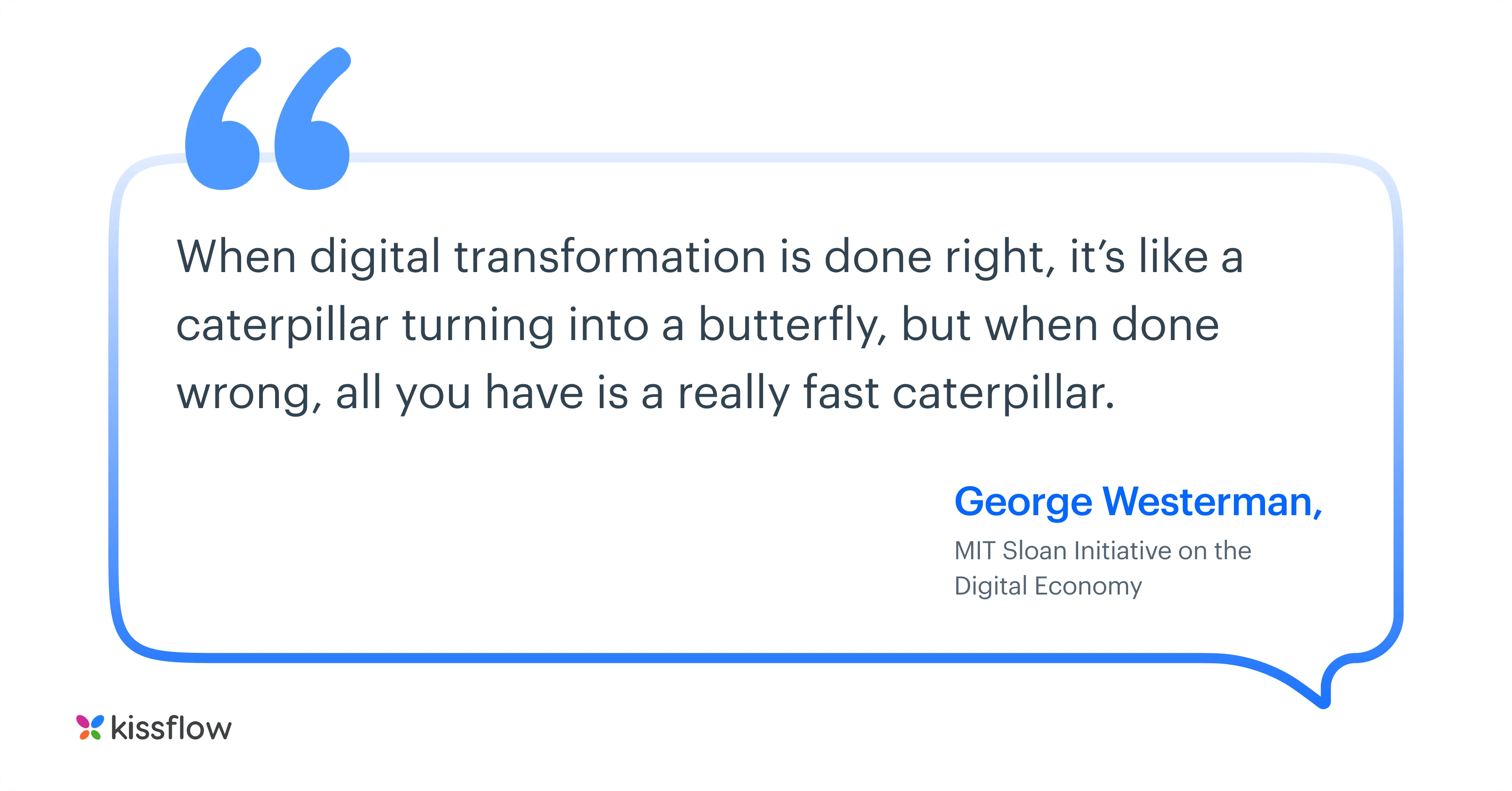
- >
- Digital Transformation >
- 11 Digital Transformation Best Practices Based on Success Stories
11 Digital Transformation Best Practices Based on Success Stories
By 2025, the global expenditure on digital transformation spending is expected to reach $2.8 trillion.
Digital transformation is on the executive agenda of many CIOs that want to prioritize organizational transformation. The focus is on using technology to improve the customer experience, adapt to the digital economy, and expand digital capabilities.
Enterprises that implement digital transformation interact better with their customers, have higher operational efficiency, and effectively promote new products and services. They also adapt quickly to changes in consumer behavior, respond to the latest market trends, and seize more growth opportunities and much more benefits of digital transformation.
But how can you ensure that your digital investments deliver returns?
These 11 best practices on digital transformation based on true success stories can helP
Why does Digital Transformation Fail?

Industry projections show that by 2025, digital transformation initiatives worth $3.3 trillion will fail. According to a Deloitte study, 70 percent of all transformation efforts fail, and even when organizations get it right, it takes about three years for them to begin competing in the digital marketplace.
There are plenty of reasons why digital transformation fails. According to the Everest Group, 73 percent of businesses that failed didn’t create any business value with their digital transformation efforts.
Here are the key reasons why digital transformation fails.
Wrong Company Culture
Successful digital transformation requires a changed mindset in the organization or initiatives will stall, underperform, or fail. Company culture is among the most impactful factors because it determines whether employees will adopt and nurture digital transformation initiatives or not. For digitization to transform business operations, you need everyone’s buy-in.
The last thing you want is to invest millions of dollars in digital solutions only for your team to ignore and circumvent them. Employees must understand and be ready to use the new technologies.
If not, you’ll have a challenge enforcing new rules and processes. Changing company culture reinvents the way your organization works. People are naturally resistant to change, so having a culture that embraces change and collaboration is essential for digital transformation success.
Lack of commitment
According to Forbes, 85 percent of organizational decision-makers believe they have a two-year timeframe to make significant advances in digital transformation or their organizations will suffer financially. But this is only possible if everyone’s committed.
If your team is not committed to digital transformation, you’ll have problems in the initial phases of implementation. Lack of collaboration and commitment causes friction and delays the implementation process. You need to ensure everyone understands the measures that need to be taken to implement the project.
Digital transformation, like any other major company project, has to begin with leadership and employee buy-in. Everyone must understand and agree to the company’s digital transformation vision. Employee motivation and skills are crucial to the success of digital transformation efforts.
Not using the right technology
For digital transformation to succeed, legacy systems must be replaced with new technology. This involves replacing traditional processes with newer, updated ones. But it's not enough to get new technology, it must be ideal for your business.
Research different solutions before settling on one and establish security and compliance infrastructure before launching it. The new technology shouldn’t align with your business requirements, but it should also integrate well with your existing technology stack.
Check out these useful digital transformation infographics
Not understanding customer needs
The most successful digital transformation initiatives are people-focused; they directly impact customers and employees. Many digital transformation efforts fail because those involved forget about transforming the customer experience.
In a constantly changing marketplace, winners are those that create amazing customer experiences and understand how customers want to do business with them. Modern consumers expect responsiveness, performance, authenticity, and consistency in messaging and tone.
A company can only achieve its digital transformation goals if everyone has a clear understanding of consumers’ changing needs and expectations. Use customer feedback on pre-existing solutions to understand which product or service features are worth retaining. Negative feedback is especially important if your business wants to respond rapidly to customer demands.
Failure to understand Digital Transformation
A past study by McKinsey revealed that only 16 percent of digital transformation initiatives successfully improved business performance and equipped organizations to sustain long-term changes.
Many business leaders implement digital transformation steps for the sake of going digital and staying ahead of the competition. They don't understand its long-term impact—process efficiency, higher productivity, resource efficiency, and enhanced customer engagement. Companies that have adopted digital transformation are 26 percent more profitable than their industry competitors–as started by an MIT study.
Many decision-makers don’t understand how digital transformation can impact their organization. Having better insights helps develop effective strategies that focus on core business operations such as marketing, sales, customer acquisition, and innovation.
11 Digital Transformation best practices based on case studies
1. Put customer needs first
Use data collected across the organization to understand who your customers are, what they want, and how they want to engage with your business. Develop a comprehensive picture of customer patterns, preferences, and pain points.
Having a clear understanding of your customer's needs and pain points will increase the chances of digital transformation success. Provide more value to customers by making it easier for them to do business with you and solve their challenges.
Let’s look at what Michelin did.
To improve customer retention rates and reduce the fuel consumption of trucks, Michelin, the global tire manufacturer, launched the EFFIFUEL initiative in 2013. It equipped vehicles with telematics systems that collect and process data on drivers' habits, trucks, tires, and fuel consumption. Analyzing this data helped fleet managers and executives make adjustments and reduce fuel consumption. Thanks to EFFIFUEL, drivers now save up to 2.5 liters of fuel per 100 kilometers.
2. Measure your success
Clearly define and predict the value digital transformation will create and find a way to track that value accurately. Outline key performance indicators (KPIs) and use them to measure your progress. It could be increased employee productivity, a better customer experience, optimized operations, and better products and services. Collect and analyze meaningful data across the enterprise regularly so you can optimize operations. Choosing the right KPIs is important to calculate the ROI of Digital Transformation.
3. Pick the right technology
Deciding which technologies to invest in determines the success of your digital transformation efforts. Don't invest in the latest tech for the sake of digitization or rush into things and overwhelm employees with multiple major changes at once. Gradually replace legacy systems and align technology to business goals using new procedures.
Here’s what Airbus did.
Airbus is the world leader in aeronautics and aerospace products and services. The company required a user-centric digital transformation solution to streamline its data analytics, technology, and machine learning tools, but this proved challenging. It later adopted open source technology and consolidated its 15 tools into one user-friendly platform. This helped it generate 290,000 visits and 2,200,000 page views in 10 months. Also, the company’s service desk now manages 30% fewer incidents.
4. Approach change systematically
Most people are averse to change, especially employees. Implementing multiple changes at once can cause digitization delays or failure. A better strategy is to transform individual processes at a time. Implement digital initiatives in stages and motivate employees to embrace change gradually. Don’t force them to change but empower them to adopt change. Business transformation requires great attention to detail, so stop regularly and review your results.

5. Engage Employee
Employees often have better insight into workflow hurdles, broken processes, and information gaps. They can give suggestions on how to optimize existing applications or how to apply new technologies for the best return on investment. Train employees ahead of time to increase their knowledge and skills.
Involving employees in the planning and implementation stages also increases their likelihood of adopting new processes and technologies. The more employees are engaged throughout the entire process, the smoother the implementation will be.
6. Prepare your company
Check out: Digital Transformation Case Studies
Management and employees don't require top tech skills to adopt digital transformation. What they need is a changed mindset. And since tech solutions automate processes for both customers and employees, growth can happen quickly internally and externally. Prepare your organization for change by recognizing which areas need change, increasing transparency, and promoting collaboration.
Follow Honeywell’s example.
The Fortune 100 manufacturer operates in industries such as aerospace and building technology. To improve product quality and make it easier to apply digital strategies, it cut its operations from eight markets to six. Early in its transformation journey, it established a digital transformation group in the company that led digital innovations like data-driven product offerings, IoT-connected devices, and advanced industrial process control. In 2018, Honeywell's share price grew from $95 to $174 and revenue went from $40 billion to $43 billion.
7. Have a clear business case
Pegging your digital transformation to a business case helps you focus on value. Avoid a vague business case that cannot be tracked. Failing to track value means you’re unable to assess what impact your business case has on the most important processes so you can’t prioritize the most critical steps. A business case provides justification for digital transformation. It outlines the details of the project and the ROI that can be achieved by moving forward.
8. Put data to work
Information silos are obstacles to smooth workflows. Creating a single source of information improves visibility in your business and makes it easier to build strong customer relationships.
Data governance helps ensure processes and business goals align with digital transformation. Empower your teams with the technology and skills needed to process data in time. You can also use data insights to guide digitization projects.
9. Link Digital Transformation to business goals
Ensure there is a clear link between your digital transformation journey and the company goals. Decide what you want to achieve from your digitization efforts. When digital transformation initiatives are connected to business goals, a company is able to fulfill tasks more effectively, retain current employees, hire new talent, and transform company culture.
For decades now, Microsoft has been one of the world’s leading tech firms. To stay competitive and build a cloud computing platform that provides easier access to technology, the company embarked on a digital transformation journey in 2014. Satya Nadella moved the company away from its desktop-driven revenue base and accelerated a shift to cloud computing. Its Office 365 and Azure cloud platform have positioned the company for the future and strengthened its market position.
10. Use agile methodologies
Successful digital transformations happen through continuous innovation—by significantly changing business models and functions in measured steps, over time, and as resources allow.
With agile methodologies, a company can update its digital strategy and respond better to customer requirements and technical challenges. It can develop products and frequently release them to the market for faster feedback.
Constantly assess your digital transformation efforts and make adjustments. Encourage employees to innovate, experiment, and take controlled risks.
11. Be transparent
Complete transparency in your operations is one way to ensure digital transformation success. Communicate consistently and let information flow up, down, and across the organization. Being transparent about what’s happening and why allows employees to prepare for changes they’re uncomfortable with. Throughout the implementation phase, find out how employees are adapting to the change. They should be able to share their opinions without fear of repercussions.
Digital Transformation tips: Scale up your process
- Facilitate a cultural change: Involve the entire organization in the digital transformation plan and initiate cultural change across the enterprise. Encourage open communication across all departments to build the right mindset.
- Choose your projects selectively: Selective digitization makes for a more efficient journey. Choose digital transformation projects based on what's best for your company. Adopt new technologies that align your projects and business goals.
- Encourage collaboration and feedback: Use collaboration and feedback to improve processes before and during digitization. Establish internal teams with common skills and interests to work on different projects.
- Focus on your roadmap: Start with the processes you want to improve and get the right technology for the job. It may take some time to find the right technology for your company, but preparing ahead of time goes a long way.
- Educate your team: Insufficient knowledge of systems and tools will prevent your employees from leveraging all the features of new tools and technologies. Without training, new systems may become inefficient or slow down daily operations.
How Kissflow helps scale up your digital journey
Some companies may struggle to implement digital transformation initiatives, but yours doesn’t have to. There’s no time like the present to launch your own digital transformation initiatives.
Kissflow is a simple, yet powerful low-code platform that can digitize your organization's internal operations and help you achieve your digital transformation objectives. The low-code platform is simple enough for business users to use and it provides industry leading process automation for streamlined workflows and highly structured business applications.
Our platform is highly customizable and allows you to implement your digital transformation projects around concrete goals and accessible metrics.
-Apr-08-2024-06-34-59-2050-AM.webp)
Evaluate your company's digital maturity
✅ Get a clear understanding of where your organization stands
✅ Uncover gaps in your digital strategy
✅ Develop a well-defined digital roadmap
Related Articles












